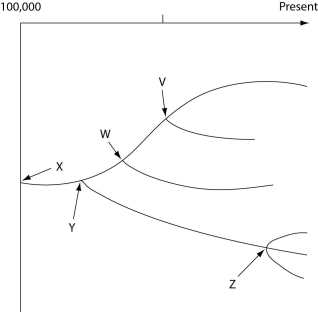The following questions refer to the evolutionary tree in Figure 22.2.
The horizontal axis of the cladogram depicted below is a timeline that extends from 100,000 years ago to the present; the vertical axis represents nothing in particular. The labeled branch points on the tree (V-Z) represent various common ancestors. Let's say that only since 50,000 years ago has there been enough variation between the lineages depicted here to separate them into distinct species, and only the tips of the lineages on this tree represent distinct species.

Figure 22.2
-Which of the five common ancestors, labeled V-Z, has given rise to the greatest number of species, both extant and extinct?
Definitions:
Urinary Tract Infection
An infection in any part of the urinary system, including kidneys, bladder, or urethra, common symptoms include pain and frequent urination.
Urodynamic Testing
A series of tests that assess how well the bladder, sphincters, and urethra are storing and releasing urine.
Involuntary Urine Leakage
The unintentional loss of urine, often referred to as urinary incontinence.
Flank Pain
Pain on the side of the body between the ribs and hip, often associated with kidney problems but can have various causes.
Q2: The major evolutionary episode corresponding most closely
Q4: Accuracy in the translation of mRNA into
Q5: Which of the following tools of recombinant
Q14: What is the function of DNA polymerase
Q23: Which of the following genes map out
Q28: Which of the following is most likely
Q41: How many separate species, both extant and
Q49: Currently, two extant elephant species (X and
Q72: Assuming that the rate of sea-floor spreading
Q74: Several scientific laboratories across the globe are